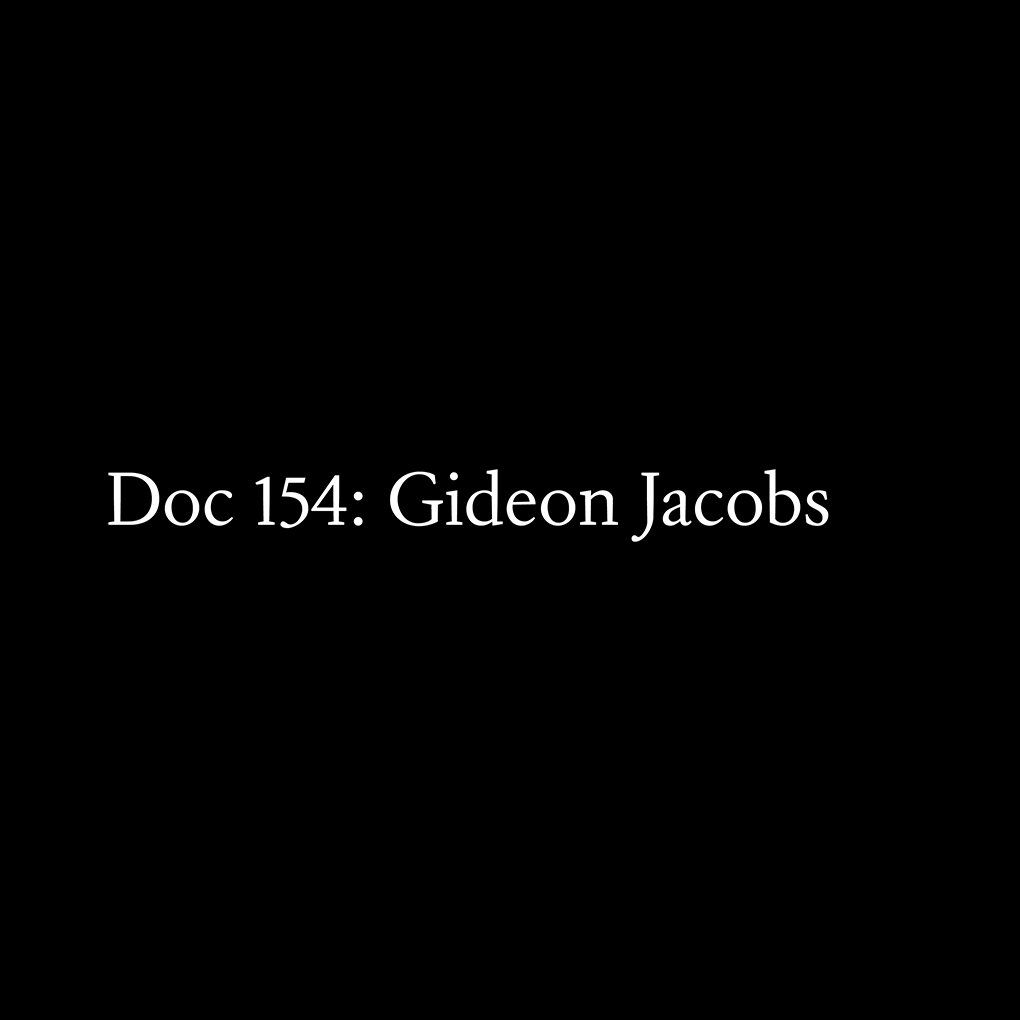
The Other Tiger1
Pico Iyer, writing of Cuba in 1994, focused on a single detail that seemed to capture the desperation of what he saw. I’ll never forget it. He said that the young girls, for lack of money for lipstick, would rub crayons on their lips to beautify themselves for the men they hoped would pay them to have sex. Iyer didn’t privilege this detail in any way. He just employs it so it could do its job. Extreme poverty, perverse resourcefulness, and voided childhoods all funnel into one crushing instance.2
Good travel writers are tuned to these moments of convergence. In the chain of new, expansive experiences of travel, certain specific moments organize and tighten the world into coherence. If the detail is good enough, the fantasy and reality of a place come forward, and various interpretations of an environment accumulate and are examined.
Paul Theroux, for instance, needed only to lean into the short description of a young boy who opened the door for him at the last residence of Jorge Luis Borges in The Old Patagonian Express: By Train Through the Americas, to give us a sense that the mystery of Borges’ writing (with all of its labyrinths, trap doors, and equations for managing infinity) came from the mystery of Argentina and its people:
The brass plaque on the landing of the sixth floor said Borges. I rang the bell and was admitted by a child of about seven. When he saw me he sucked his finger in embarrassment. He was the maid’s child. The maid […] who invited me in, then left me in the foyer with a large white cat. There was one dim light burning in the foyer, but the rest of the apartment was dark. The darkness reminded me that Borges was blind. 3
Theroux puts us in Borges’ story (the sucked thumb, the large white cat, the one dim light): most things are normal and some things are strange, but everything falls under flat finish of simple description. As such, Theroux says that one need not abstract a labyrinth, dream up an Aleph (a point in space that contains all other points in space), or even know anything about Borges at all, to be susceptible to certain fantastic rules about our place in world. You may not know how to frame that strange feeling, the feeling of one dim light speaking to blindness and the strange sudden companionship of a small boy and a white cat, but you know that this strangeness somehow animates and contradicts what we know and conventionally experience of the world.
I’ve been thinking about this moment in Theroux in order to comprehend what has become a legitimate meta-reality: the existence of the wonderful and terrible device of Google Street View. The Google Map team is intent on nothing less than a complete snap-shot of every spot on earth. Not only have they accomplished a fair amount of this task, but we are already bored with it. Google Maps only launched in 2005, but it feels as though it has been around much longer. Street View was added in 2007, and it is now a matter of routine to democratically, regardless of who we are, become the ubiquitous Pegman (Google’s avatar for Street View) and use his arrows and circles to guide us around a neighborhood or field. Like Theroux in the world of Borges, we are travelers in this alternate reality, we are the people that stare into this clumsy mirror. It is up to us to determine the significant details in a world which aims to capture every detail all at once. In the domain of Google Street View, what will be the white cat, what will be the bit of strangeness that brings us back to ourselves in this virtual space?
In a certain sense, your computer, while running Google Street View, functions as the Aleph. It aims for nothing less than to be a point in space that contains all other points in space. It is as glorious as an aurora, and as boring as a can opener. It has the capacity to enchant, yet it is used mostly as a tool. With a purpose, clicking the arrows like hitting a coconut with a sharp rock, I have screened beaches in Maui, checked out restaurants, and made sure that I am at the right building for an appointment. I’ve used it to conjure memories of a place that I may have forgotten in order to get details for an essay. I’ve recreated historical situations and paths that historical figures apparently took. One evening, from my desk in Culver City, I returned to Kenya, where I used to live, to see if the trees I planted were still growing (they weren’t).
However, Google Street View becomes most interesting when it is not directed, when the rush of knowledge of the Aleph takes on the desperate tangled circulation of the labyrinth, when you start to feel the length, silence and distance of this new and clumsy omnipotence. It happens when you wander from your purpose and just become Pegman. Like Edgar Allen Poe’s Man of the Crowd, your purpose is unclear but you proceed anyway, as if only by momentum. I can only compare it to visiting a country for the first time, acquainted with a burst of imagination and a hunger for knowledge, but then this feeling suddenly collapses into a particular flatness and the recognition of
a break between your eye (which has taken over) and the retreat of your body (which is not involved) becomes a sort of ennui.
Although, Street View can become a literary project, and it has its travel writers. Not only that, it has the power to critique itself from the inside. There are moments in Street View where the larger story and its apparent conflation with reality is shattered by the opposing truth of details that rise up in silence and vanish. In Street View, there is a Borgesian sense of vast space and boredom and desperation mixed with the Borgesian encounter, not epiphanies but instead moments where details collapse into unknowing.
In 2008, Canadian artist Jon Rafman4 entered Google Street View to navigate “the conflict… between an indifferent robotic camera and man’s search for connectedness and significance.”5 Called the Nine Eyes Project, Rafman finds, captures, and reprints an endless stream of the fantastic, the startling, and the unexplainable out of the vastness of the Google machine. Unlike other photographers that use Google, Rafman does not seem to have a direct intent for his wandering. He is not trying to bring awareness to various human rights issues as the work of Mishka Henner or Doug Rikard does, respectively searching for sex workers in plain sight or calling attention to the urban ennui of downturned or poverty stricken locals.6 Nor does Rafman use Google as a tool for predetermined conceptual projects as Michael Wolf does, who seems to begin his use of Street View armed with a specific goal in mind (Wolf, in his work, has made suites of Google portraits and he has used Google to collect various impressions of New York City).7

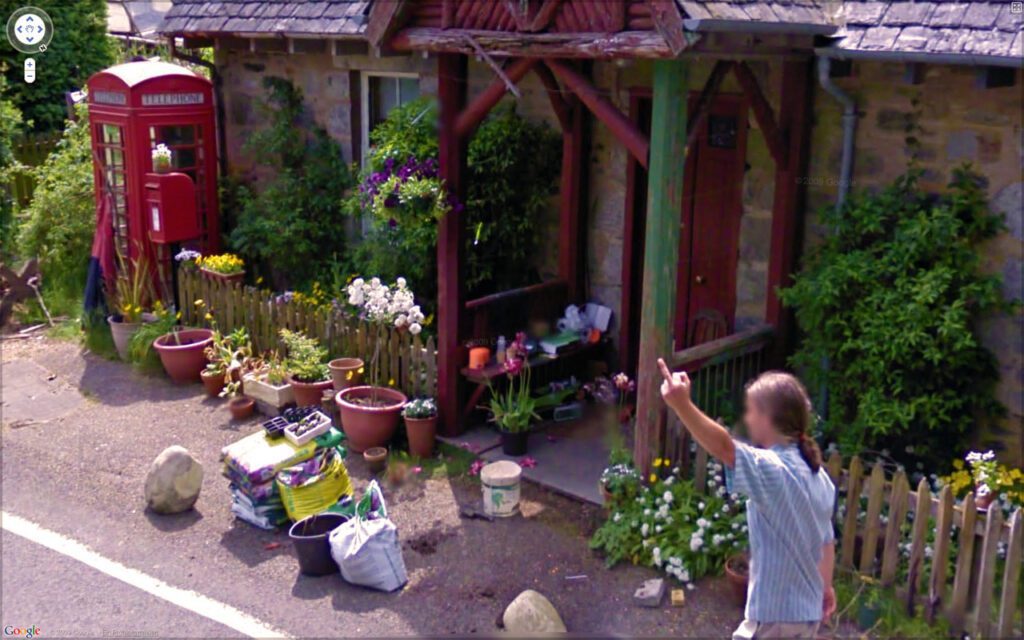
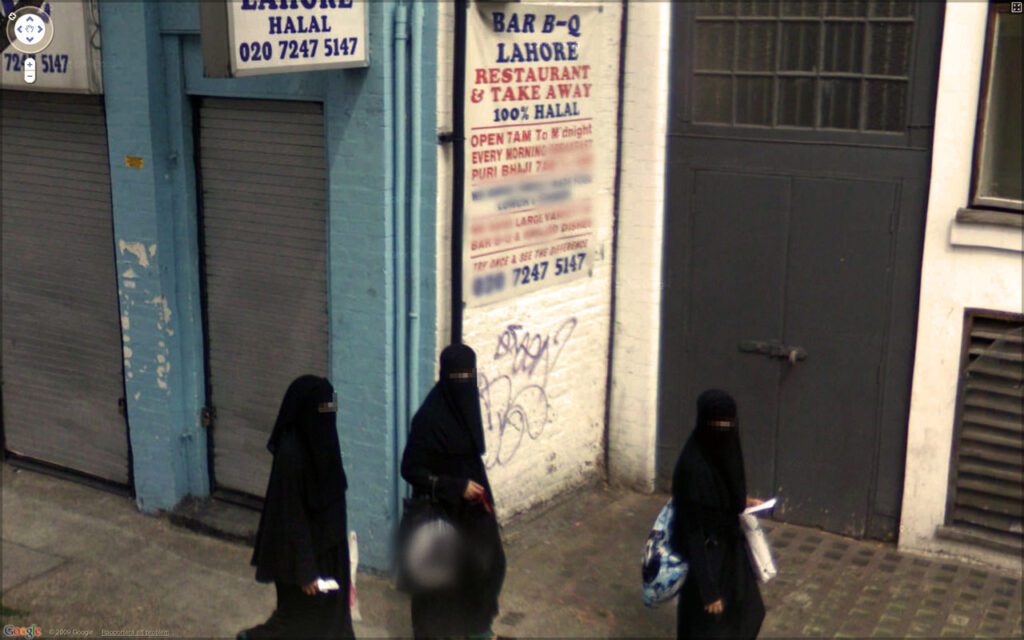
Images accessed from Jon Rafman’s Nine Eyes of Google Street View archive at 9-eyes.com
Instead, Rafman is a sort of enigmatic Virgil. He walks the paths of Google, recognizing its inhabitants and documenting the strange. His project gives the impression that he is just strolling, collecting anything and everything. It is a large stockpile, curated by a sensitive eye. I consider Rafman’s collected images as instances in Street View that spring out of the ordinary into view, instances that compete to give extended meaning to endless, renewable sets of data. If one were looking for Theroux’s boy or white cat in Rafman, there are many things to choose from. For example: there is a man tied up and held at gunpoint in the back of a truck. We see the wall of a makeshift slum shelter on which images of Disney’s Snow White are sadly pinned. A VW Bus is inexplicably on fire. Sometimes, it is Google that is elevated in Rafman’s work: we marvel over its intrusive ability to track the world. However, there are other moments that, to me, are more important. These moments exist with Iyer and Theroux, portraying aspects of human experience that might be framed by Google but are not contained by it. There are punctures in the corporate totality.
One of the paradoxes of Rafman’s project is that after scrolling hundreds of his images, it is human behavior that is the first to feel familiar. The glimpse of what looks like a dead body on the road or crimes in the midst of being committed is initially striking, but it is even more striking how little Rafman’s photos are capable of holding that visual charge, how quickly the photography of car hijackings become ordinary. Yes, to see a gun is a jolt, but it is quickly assimilated as it would be in a television show. The gun’s presence fades into an ordinary reality. It is the same with car crashes and disasters of any kind. The repetition of those visions in Rafman’s view go the way of Andy Warhol; they go the way of the unfortunate condition that spectacles do not hold for long.
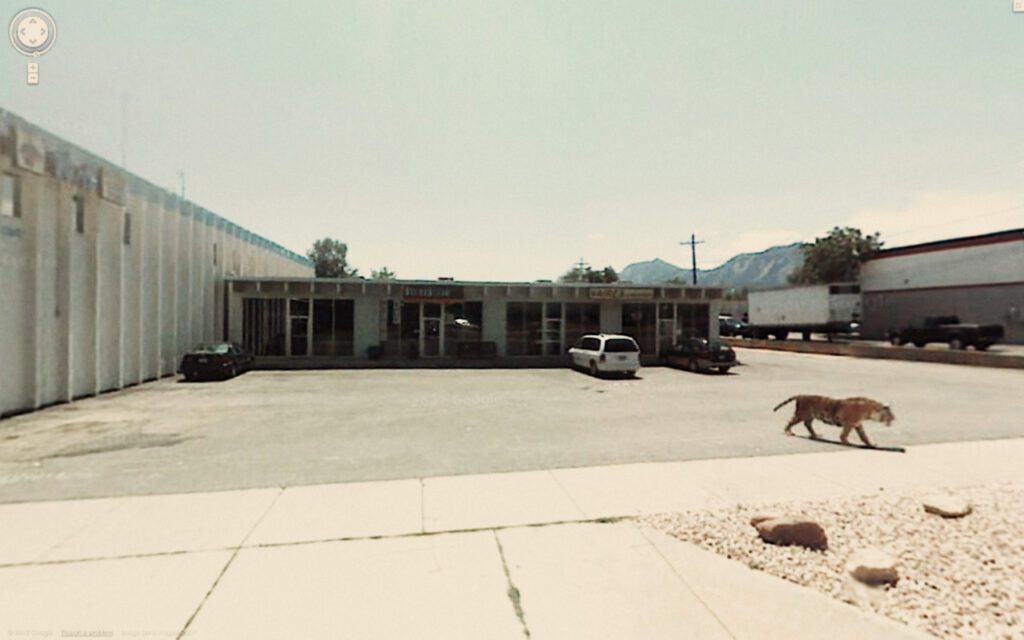

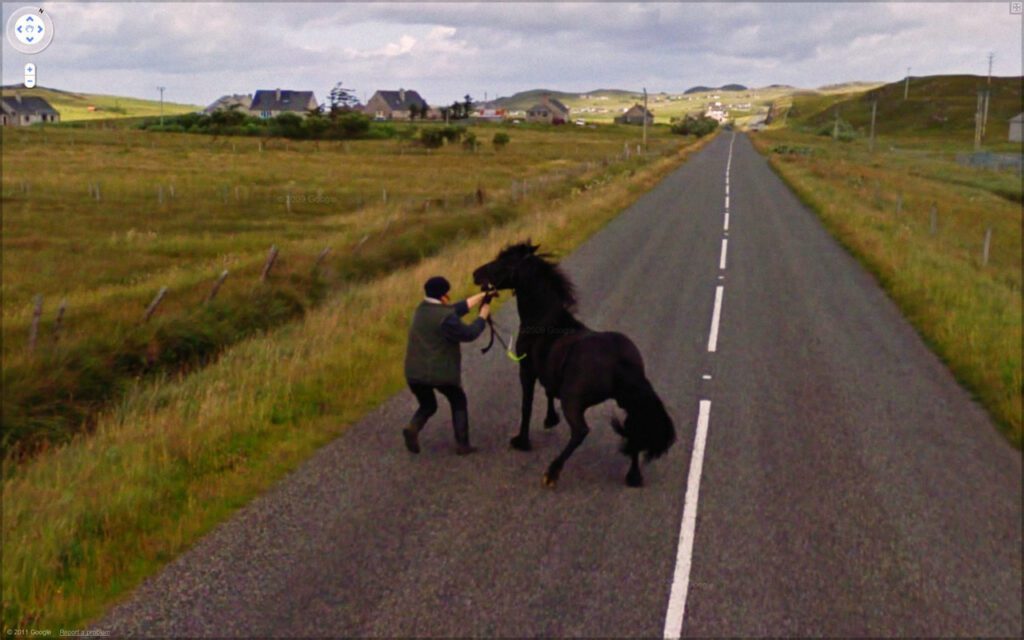
Images accessed from Jon Rafman’s Nine Eyes of Google Street View archive at 9-eyes.com
Or, perhaps there is a deeper way of looking at it. Maybe these moments, in that they represent the extremes of human activity, are accustomed to the camera. These are the moments in life that have the look of things that are looked at. I am sure that different people are startled by different photographs by Rafman, but the photographs that I find the most powerful are not the photographs that highlight Google’s ability to discover and show the typical narratives of life and death, but the ability of the world or humans to elude or hide in plain sight, those times where the distance between the medium by which you are interpreting reality (Google) is seen as impossibly distant from the reality of the situation as it occurs in the world. The equation, in other words, succeeds, but is unsatisfactory.
There’s a man waiting on an empty road, for instance, and Google might as well be shattered by his inability to be known. The photograph is all questions and no answers. There are many photos of people in masks in Rafman’s photos but this man perhaps wears the most intense mask of all. In his passivity, his focus on the road, he does not realize the Google car is coming, nor, if the Google car has already passed him and is photographing him from behind, does the man count the Google car as an unusual sight. He is waiting for something that must come from the horizon. He does not care about the position from which we are looking. He is out of the Google world. The force by which the man keeps his own counsel lingers in a powerful fashion.
Another instance where you become both painfully aware of Google’s medium and the incredible distance and inadequacy of the nine eyes is the sight of an unattended baby crawling on the sidewalk in front of a Gucci store. This is no spectacle. The baby is alone. There is no funny narrative available to make the scene comic or distasteful. The baby is crawling, helpless in the most ordinary of worlds. The baby is perhaps different from the old man; consciousness does not draw its gaze from the Google camera elsewhere. The baby’s consciousness is not robust enough to know why the Google camera would be extraordinary at all. The baby does not see us looking, making our helplessness to offer the baby aid all the more poignant and piercing.
Consciousness seems to be an important factor in the ability of Rafman’s photos to hold their power. I would argue that it is not humans at all but the appearance of animals in the Nine Eyes project that have the uncanny power to shatter the fiction of the Google camera. They puncture its arrogant claims for omnipotence. They do not resist the camera’s gaze; they do not register its gaze at all. There is a photo, perhaps Rafman’s most famous, of a tiger simply walking through a parking lot. Instead of a narrative rising up to meet and define this extraordinary event, we just get the picture. Here, simple and biting, is a moment where we exist in the labyrinth and the Aleph at the same time; helpless are we to understand in the midst of such unconscious immortality how powerfully the beast stalks us. The Minotaur has found us. Here is that magic portal of a detail; Rafman’s travel writer moment.
There are more, even more special such moments. A wild horsefeeds off human trash. A cow with a broken back drags itself across a road in its dying moments. A bird flies up into the lens. A moose runs out ahead of us. A large white cat in the foyer. A boy sucks his thumb. A single light in the house of blind man, the ordinary filling up with what it cannot know. A broken, ruined cemetery on the outskirts of somewhere, on the edge of a coast. The cemetery is ancient, but it is equally capable of being ancient now as it will be capable of being ancient hundreds of years from now. In the background, running wild with its brother, free and open and unable to be framed by any eye that looks: a single white horse.
In these moments, I think to Borges and come to think that Street View is yet another unsatisfactory equation for containing infinity.
1 See Jorges Luis Borges, Borges: Selected Poems, Edited by Jorge Luis Borges and Alexander Coleman, Penguin Books; Reprint edition (1st April 2000), 114.
2 Pico Iyer, “Castro’s Resilient Masses,” New York Times, 31st August 1994.
3 Paul Theroux, The Old Patagonian Express: By Train Through the Americas (Boston: Houghton Mifflin, 1979).
4 My hope here is not to introduce Rafman. His project has been written about often by newspapers and magazines. Instead, I wonder if the discourse on this project could be taken deeper. I wonder if a little extended sensitivity or criticality can be applied to his photos.
5 Ewan Palmer, “Nine Eyes of Google Street View: Jon Rafman’s Exhibition Captures Stranger Side of Google,” International Business Times (London), 26th July 2012.
6 See Mishka Henner, “No Man’s Land,” Photography, 20in.×24in. collected in No Man’s Land Volume I and II (Print-On-Demand Books, 2011) and Doug Rikard, A New American Picture (New York: Aperture Foundation, 2012).
7 Michael Wolf, asoue (a Series of Unfortunate Events) (Berlin: Peperoni Books, 2010).
Ed Schad is a writer and curator living in Los Angeles. His writing has appeared in The Brooklyn Rail, Los Angeles Review of Books, Art Review, and Art Slant, among other publications.
